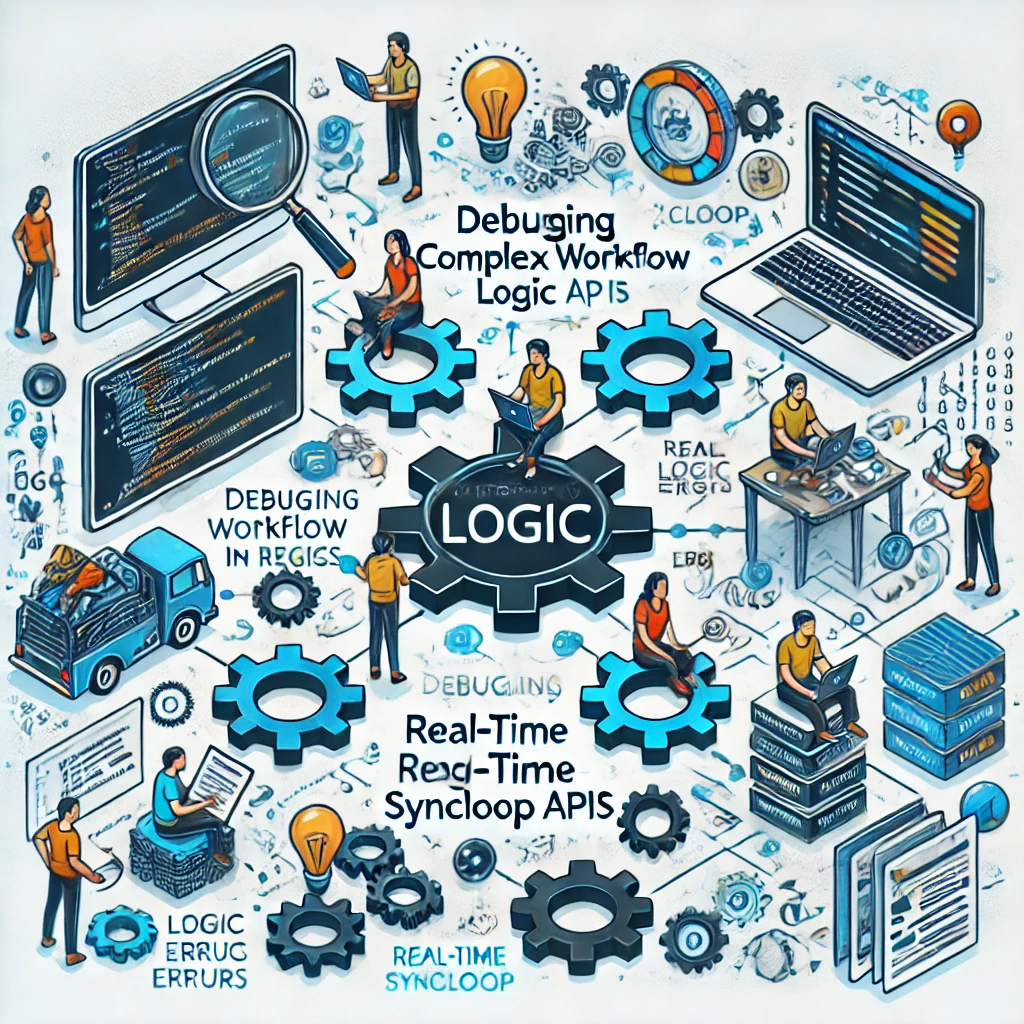Debugging Complex Workflow Logic in Real-Time Syncloop APIs

Syncloop provides robust debugging features to streamline troubleshooting of complex workflows in real-time APIs. With capabilities like workflow visualization, real-time monitoring, and automated error handling, Syncloop simplifies the debugging process. This blog explores how to debug complex workflow logic in Syncloop APIs and shares best practices for efficient troubleshooting.
Why Debugging Workflow Logic Is Challenging
- High Interdependencies Errors in one component can cascade across dependent processes.
- Dynamic Data Flows Real-time workflows handle constantly changing data, increasing complexity.
- Concurrency Issues Simultaneous execution of workflows can result in conflicts or data mismatches.
- Limited Visibility Identifying the root cause of errors in multi-step workflows can be difficult without proper tools.
- Time Sensitivity Real-time workflows require immediate resolution to prevent disruptions.
How Syncloop Simplifies Workflow Debugging
Syncloop provides comprehensive features to debug complex workflows:
- Workflow Visualization Map out workflows to understand dependencies and interactions.
- Real-Time Monitoring Track the execution of workflows and detect anomalies instantly.
- Detailed Logs Capture logs for each step in the workflow, including data inputs, outputs, and errors.
- Automated Error Handling Configure retries, fallbacks, and notifications for workflow errors.
- Testing and Simulation Validate workflows in a controlled environment to identify potential issues before deployment.
- Analytics and Insights Use performance metrics to optimize workflows and prevent recurring issues.
Steps to Debug Complex Workflow Logic in Syncloop APIs
Step 1: Visualize Workflow Execution
Use Syncloop’s visualization tools to:
- Map the workflow, highlighting interdependencies between components.
- Identify points of failure or delays in the workflow.
- Understand the flow of data and execution paths in real time.
Step 2: Monitor Real-Time Metrics
Enable real-time monitoring to:
- Track key metrics such as latency, throughput, and error rates for each workflow step.
- Identify trends or anomalies in workflow performance.
- Detect bottlenecks in specific components or processes.
Step 3: Analyze Detailed Logs
Review logs captured by Syncloop to:
- Understand the state of the workflow at the time of failure.
- Identify discrepancies in data inputs or outputs.
- Correlate errors with specific components or steps in the workflow.
Step 4: Test and Simulate
Simulate workflows in Syncloop’s test environment to:
- Validate workflow logic under different scenarios and data conditions.
- Test edge cases and error-handling mechanisms.
- Fine-tune workflows for better performance and reliability.
Step 5: Automate Error Handling
Leverage Syncloop’s automation tools to:
- Retry failed steps with exponential backoff.
- Implement fallback mechanisms for critical workflow components.
- Notify relevant teams or trigger alerts for unresolved errors.
Step 6: Optimize Workflow Logic
Use insights from Syncloop to:
- Simplify overly complex workflows by breaking them into smaller, manageable components.
- Optimize resource allocation for high-demand steps.
- Update workflows to address identified bottlenecks or inefficiencies.
Best Practices for Debugging Complex Workflows
- Implement Granular Logging Capture logs at every step to provide comprehensive visibility into workflow execution.
- Focus on Critical Paths Prioritize debugging workflows with the highest impact on user experience or operations.
- Use Real-Time Tools Monitor workflows continuously to detect and resolve issues before they escalate.
- Validate Data Integrity Ensure data consistency and accuracy across workflow components.
- Document Workflow Logic Maintain clear documentation to simplify debugging and collaboration.
Example Use Case: Real-Time Order Processing
An e-commerce platform uses Syncloop to debug its real-time order processing workflow:
- Workflow Visualization: Maps the process from order placement to fulfillment, highlighting dependencies between inventory checks, payment validation, and shipping updates.
- Real-Time Monitoring: Tracks latency and error rates in critical steps, such as payment processing.
- Detailed Logs: Captures logs for failed payment validations, including input data and API responses.
- Simulation: Tests the workflow under high traffic conditions to identify bottlenecks.
- Automation: Implements retries for failed inventory updates and fallbacks for payment gateway errors.
Benefits of Using Syncloop for Workflow Debugging
- Faster Issue Resolution: Identify and resolve workflow errors quickly with real-time tools.
- Enhanced Visibility: Gain a clear understanding of workflow dependencies and execution paths.
- Improved Reliability: Minimize workflow disruptions with automated error handling.
- Optimized Performance: Use analytics to refine workflows and improve efficiency.
- Proactive Management: Detect and address potential issues before they impact users.
The Future of Workflow Debugging
As workflows grow more complex and interconnected, efficient debugging will become increasingly critical for maintaining operational excellence. Syncloop provides developers with the tools to visualize, monitor, and optimize workflows in real time, ensuring seamless and reliable API operations.
Image Description
A conceptual illustration showcasing Syncloop’s tools for debugging complex workflow logic in real-time APIs, featuring workflow visualization, detailed logging, and automated error handling. The image highlights seamless and efficient API operations in dynamic environments.
Back to Blogs